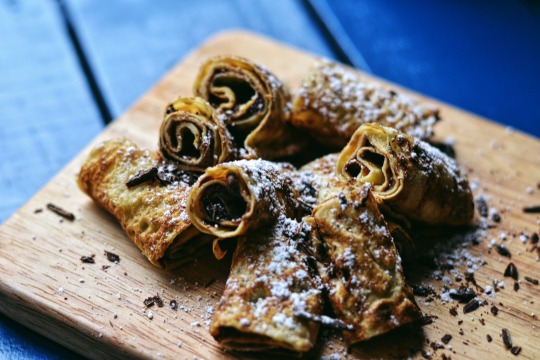
Nothing is more comforting in cold weather than a fresh, warm and gooey cinnamon roll, am I right or am I right? Yeah. I’m right. Cinnamon rolls have always been there for me, through the good and the bad. If you’re having a tough day there’s nothing that 2 (or 3 or 4 or 6) warm cinnamon rolls won’t fix.
What happens in my home lately goes like this: I write and test recipes, photograph them, and then I’m left with copious amounts of pastries and snacks. It sounds like a dream, doesn’t it? I’ll admit that it’s very dreamlike until there’s a
Bûche de Noël taking up an entire shelf of your tiny French refrigerator. Your conscience says no, but your body and your heart say yes and before you know it, you’ve blacked out and eaten enough for six people. Just kidding, what? Of course I would never do that. That’s just ridiculous…


This recipe will make 6 cinnamon rolls. You can make it by hand, or with the help of a mixer. I recommend using the mixer for this because it can be tough to incorporate the second half of the flour, but it can be done!
I like to bake mine in a muffin pan. This constricts the area they grow in, and pushes them up to be taller, which I like. The sugary filling also caramelizes around the bottom of the muffin pan, giving you a truly sticky and gooey roll. This is my favorite part. But! Never fear, they don’t have to go into a muffin pan! For larger, fluffier rolls, just pop them on a baking pan. They will spread more, and they will still taste amazing.They will also get a little more crispy, so if that’s something you prefer you should just nix the muffin pan idea.


Ingredients:
¼ cup (50g) of white sugar
½ stick (56g) of butter, cut into cubes
1 pkg (7g) instant yeast
2.75 cups (350g) of all-purpose flour
2 eggs, beaten
½ cup (120g) whole milk, warm
1 teaspoon salt
For Filling:
Room temperature butter, or melted
¼ cup (55g) brown sugar
½ cup (50g) white sugar
1 tablespoon of cinnamon
1. Combine warm milk with yeast and set aside.
2. In bowl of mixer, combine sugar, flour, salt, and butter (not warm but not cold). Run on low speed with paddle attachment until you see no more butter chunks, about 5 minutes.
3. Add beaten egg to milk and yeast mixture.
4. With machine running on low to medium speed, pour in the liquid. Let combine fully, then turn up the speed for 1 minute. Turn off mixer. Cover with a kitchen towel and proof for about an hour or until doubled.
*At this point you can refrigerate overnight and shape the next day, then proof for 1 hour if you prefer.*
5. Empty the dough out onto a floured work surface and roll it into a rectangle (my measurements are about 7″ x 9″). Don’t roll it too thin or your rolls won’t hold up well. Butter the entire surface and sprinkle with the cinnamon sugar mixture and a bit of salt. Roll up the rectangle and cut it into six rolls. Proof for one hour.
6. Egg wash and bake in an oven on 375 degrees for about 14 minutes or until a lovely brown color is reached. Drizzle with a mixture of 1 cup powdered sugar and about 2 tablespoons of milk… Or enjoy it without the glaze!
Thanks for reading, like my new Facebook page for more updates!





































